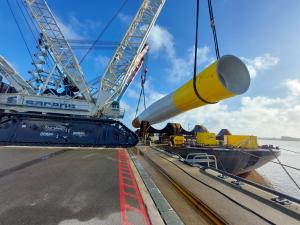Offshore wind could contribute more than $40 billion to Australia's GDP between 2027 and 2040
It’s estimated that offshore wind in the country could support more than 23GW of output, which could supply more than 20 million homes with renewable energy.
PERTH, QUEENSLAND, AUSTRALIA, May 25, 2025 /EINPresswire.com/ -- Offshore wind energy will play a very important role in Australia's future. On the one hand, due to the need to replace more polluting sources of energy generation in line with the Capacity Investment Scheme (CIS) initiative launched by the Australian government to facilitate the energy transition, but also from an economic point of view, since the commitment to the construction of offshore wind farms could mean a contribution of more than $40 billion to the country's GDP between 2027 and 2040, according to forecasts made by the Clean Energy Council.Although there are still no offshore wind farms under construction -as opposed to the 90 onshore wind farms already in operation in the country-, 12 feasibility licenses were granted last year in the Gippsland region (Victoria), the most favorable region for the installation of this type of infrastructure -along with Newcastle, in New South Wales and Gladstone, in Queensland-, as a step prior to the start of the installation works. However, the inadequacy of the country's port infrastructures to meet the necessary requirements for loading and unloading materials onto barges and the marshaling of wind turbine components -jackets, transition pieces and turbines- continues to be one of the main obstacles to the proper development of these wind farms.
In this regard, Sarens, world leader in heavy lifting, engineered transport and crane rental services, is calling on public and private entities in the country to make a firm commitment to the renovation of port infrastructures, providing them with the necessary facilities to carry out the loading and unloading of materials in the necessary conditions of safety and efficiency.
With two offices in Australia (in Brisbane, Queensland and Perth, Western Australia), Sarens has a technical staff highly specialized in the tasks required for the installation of offshore wind farms in any of the coasts of the country, with the necessary capacity to advise its clients to identify their needs in terms of machinery and transport solutions, as well as in the necessary modifications and adaptations to be carried out in the points where the projects are developed. In addition to having a complete fleet of local machinery, Sarens has different alternatives spread around the world that can be mobilized at any time to meet any requirement of its customers, regardless of the complexity or the load that needs to be moved.
Offshore wind energy is expected to be a major source of job creation in the expansion areas, with more than 8,000 new jobs per year from 2030 onwards, with more than 19,000 jobs created in peak construction and more than 7,000 in the operation of the farms. Once all the farms planned for the next few years are operational, it is estimated that more than 23 GW of production will be contributed to the national energy system, which could supply renewable energy to more than 20 million homes, according to PWC's forecasts in its report “Australia's pathway to energy transition is blowing in the wind”.
Sarens has extensive international experience in the assembly and maintenance of wind farms. It has participated in various installations in France such as Fécamp, Saint Nazaire, Provence Grand Large and in the lifting and transport work for the foundation bases of the new offshore wind farm in Saint Brieuc, located off the Brittany coast. During this project, Sarens successfully transported loads weighing over 1150 tons. More recently, Sarens has been actively involved in the reception and loading operations of monopiles and transition pieces for 176 turbines for the Coastal Virginia Offshore wind farm in the US and the marshalling and installation of 62 monopiles in the Moray West offshore wind farm, each weighing up to 2000 tons, the largest and heaviest XXL monopiles ever to be handled in the UK.
Sarens LeanFactor Team
LeanFactor Global Communication
sarens@leanfactor.net
Visit us on social media:
LinkedIn
Instagram
Legal Disclaimer:
EIN Presswire provides this news content "as is" without warranty of any kind. We do not accept any responsibility or liability for the accuracy, content, images, videos, licenses, completeness, legality, or reliability of the information contained in this article. If you have any complaints or copyright issues related to this article, kindly contact the author above.
Accounts Receivable Outsourcing Services Support Financial Clarity Across U.S. Healthcare
American Receivable Celebrates 46 Years of Success and Steady Leadership
Global Ready-Mix Concrete Market Is Expected to Reach $704.2 Billion by 2030: Says AMR
Więcej ważnych informacji
 Jedynka Newserii
Jedynka Newserii

 Jedynka Newserii
Jedynka Newserii

Polityka

D. Joński: Nie wiemy, co zrobi Rosja za dwa–trzy lata. Według duńskiego wywiadu może zaatakować kraje nadbałtyckie i musimy być na to gotowi
Zdecydowana większość krajów unijnych wskazuje na potrzebę wzmocnienia zdolności obronnych Europy w obliczu coraz bardziej złożonego geopolitycznego tła. Wywiady zachodnich państw wskazują, że Rosja może rozpocząć konfrontację z NATO jeszcze przed 2030 rokiem. Biała księga w sprawie obronności europejskiej „Gotowość 2030” zakłada m.in. ochronę granic lądowych, powietrznych i morskich UE, a sztandarowym projektem ma być Tarcza Wschód. – W budzeniu Europy duże zasługi ma polska prezydencja – ocenia europoseł Dariusz Joński.
Transport
Duże magazyny energii przyspieszą rozwój transportu niskoemisyjnego w Europie. Przyszłością może być wodór służący jako paliwo i nośnik energii

Zmiany w europejskim transporcie przyspieszają. Trendem jest elektromobilność, zwłaszcza w ramach logistyki „ostatniej mili”. Jednocześnie jednak udział samochodów w pełni elektrycznych w polskich firmach spadł z 18 do 12 proc., co wpisuje się w szerszy europejski trend spowolnienia elektromobilności. Główne bariery to ograniczona liczba publicznych stacji ładowania, wysoka cena pojazdów i brak dostępu do odpowiedniej infrastruktury. – Potrzebne są odpowiednio duże magazyny taniej energii. Przyszłością przede wszystkim jest wodór – ocenia Andrzej Gemra z Renault Group.
Infrastruktura
W Polsce w obiektach zabytkowych wciąż brakuje nowoczesnych rozwiązań przeciwpożarowych. Potrzebna jest większa elastyczność w stosowaniu przepisów

Pogodzenie interesów konserwatorów, projektantów, inwestorów, rzeczoznawców i służby ochrony pożarowej stanowi jedno z największych wyzwań w zakresie ochrony przeciwpożarowej obiektów konserwatorskich. Pożary zabytków takich jak m.in. katedra Notre-Dame w Paryżu przyczyniają się do wprowadzania nowatorskich rozwiązań technicznych w zakresie ochrony przeciwpożarowej. W Polsce obowiązuje już konieczność instalacji systemów detekcji. Inwestorzy często jednak rezygnują z realizacji projektów dotyczących obiektów zabytkowych z uwagi na zmieniające się i coraz bardziej restrykcyjne przepisy czy też względy ekonomiczne.
Partner serwisu
Szkolenia

Akademia Newserii
Akademia Newserii to projekt, w ramach którego najlepsi polscy dziennikarze biznesowi, giełdowi oraz lifestylowi, a także szkoleniowcy z wieloletnim doświadczeniem dzielą się swoją wiedzą nt. pracy z mediami.





![Nestlé w Polsce podsumowuje wpływ na krajową gospodarkę. Firma wygenerowała 0,6 proc. polskiego PKB [DEPESZA]](https://www.newseria.pl/files/1097841585/fabryka-nesquik_1,w_85,r_png,_small.png)




.gif)

 |
| |
| |
|